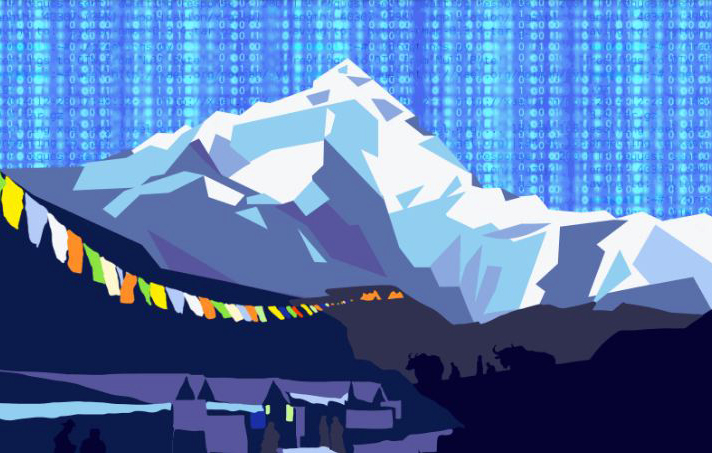Dr M N Rajesh, Assistant Professor, Department of History, University of Hyderabad, Hyderabad.
This article appeared in the Special Issue 2015 edition of the Tibetan Review, published in association with the JNU Tibet Forum. Excerpt from the 1st annual symposium in memory of Prof. Dawa Norbu organized on April 7, 2015.
Prof Dawa Norbu was one of the few Tibetan scholars who have left a lasting impression on the academic world with his sharp and creative analysis that has stayed on unchallenged for more than two decades now when the lifetime of many books is just a few years. Never shying away from newer topics and challenges, his inspiration and guidance has moulded a generation of students and it is only apt and a small tribute to his memory to work on the new media, a topic that concerns Tibet in many ways today.
“Tibetans in exile are embracing the Internet today like they did Buddhism 1300 years ago”,1 so goes the popular quotation in a book by a celebrated writer and activist Thubten Samphel and it marks the first large-scale encounter of Tibetans with the cyberspace nearly a decade ago. A decade is a small period in conventional industrial societies but in cyber world were milliseconds mean millions 2, a decade is a very long way and it is to mention that just as the Industrial Revolution transformed the way we do things nearly 300 years ago, we are on the brink of another new revolution- the information revolution.3
What the Tibetan encounter reveals is a part of the fundamental shift, an adjustment to the world to the new reality of computer mediated communication. Alvin Toffler was the first to point out that there was something wrong with the Industrial Revolution and that the road America was taking was not leading anywhere, showing insufficient results and this was a shift to a new period that we have still not clearly defined or understood. Humanity first shifted to an agrarian society from a hunter gatherer society nearly a three thousand years ago.4 As Zaki Ali Yamani had pointed out that the Stone Age did not end for lack of stones and most of the societies shifted to agriculture.5 The prosperity of the agrarian societies continued and none of the agrarian societies returned to be pre-agrarian setup. Though there was resistance to this, the high returns and complex social organizations led to the consolidation of the agrarian societies. Surplus was enhanced by a trade and India and China became the two stars that controlled nearly 50 per cent of the world trade till the 18th-century. Historian’s label the aftermath of this moment as the great divergence-a period when the Industrial Revolution took place in Europe and a new set of rules were being established. India and China would not do it in the changed manner of new enterprise and thus missed the bus; today Tibet is on the verge of missing the bus. Once again a similar transformation is taking place and the term ‘knowledge economy’ which is another open moment and one of the few open moments in history is being inaugurated. An open moment is defined as the period when multiple possibilities or options are available and societies can be reorganized. This reorganization of society is possible only with the restructuring of the production process.
In the 1950s, the most promising country in Asia was Burma, with the huge natural wealth of timber and the large resources of rice, while in 1953, South Korea was the poorest nation in the whole world and today Burma is one of the poorest countries in Asia, whereas Korea has become the 15th richest country in the world and ranks number four in the global patent regime.6 The rise of the knowledge economy does not mean the total replacement or substitution of the traditional bricks and mortar economy but the successful digital interface in production and consumption.7
The question next is who benefits from the knowledge economy and history has shown us that those who do not engage with the changed realities are bound to face the consequences. The classic case of Tibet not engaging with the outside world or proclaiming its independence in different flora internationally is an important case in this point. South Korea has managed to rise from the status of the poorest country to an advanced knowledge economy based on its human resources. What then is the road for Tibet?
Going back to the issue of Tibet’s engagement with the internet and the new media and see that most of the Tibetan people are either passive consumers or are only fringe players in the media activism. Two issues immediately come up to mind, one is the nature of Tibetan engagement and secondly ITS effects in the international and world politics.
Tibet has become a contested region in cyberspace and none other than China has understood this best. The most important symbol of Tibet, the Dalai Lama who is the rallying symbol of Tibet is strangely absent or demonised in the Chinese cyberspace.8 It was assumed that with the entry of capitalism and globalisation all countries are moving towards market capitalism and western-style of democracy, as propounded by Francis Fukuyama9 and in the case of China it was reiterated by many who expected China to open up after the introduction of market reforms and free flow of information.
However, while many countries have closed their cyberspace to the outside world and live in isolation like North Korea, or relatively Saudi Arabia and Iran, China has on the other hand fully engaged with the new media and has seen to it that its pre-eminent position in the global economy is in large contributed by the changed forms of production and trade and thus China has managed to leverage the benefits while at the same time control the media. The best example of such an enterprise is the website Alibaba.com which is the world’s largest online market place for trading commodities and also has successfully managed to regulate traffic which is in the nature of millions every day.10 In spite of such traffic and transfer of large-scale information and commodities there has been no seditious activity detrimental to the interests of China that has managed to surface on this website.
We have people from more than a hundred countries trading on this website including commodities like flags of countries that are banned in the native country but we do not have any flag of Tibet being sold here. Similar tight measures are there in place all over China and the most extreme example of this is the deletion of the word jasmine in all their websites after the Arab spring.11 This leads us to another question of the Tibetan presence in Chinese websites and we see that the image of the Dalai Lama or any other such personalities or issues are totally suppressed.
In the mediaeval period, after the fall of the Yuan dynasty, the Mings came to power and realised that the Great Wall of China was not effective and that the real Great Wall of China were the Mongol warriors who guarded the frontiers of inner Asia.12 Similarly in the modern day situation, the Chinese cyberspace is characterised as the Great Fire Wall of China and the spread of this wall is not only within China but also beyond which is where the whole question of global capitalism comes.13
Samdong Rinpoche in this work Uncompromising Truth For a Compromised World highlights the predominance of pragmatic and material judgement to the relegation of the moral and ethical, thereby promoting a value system and society where there is no place for humanity and morality.14 It is common knowledge that China is not alone in this venture of cyberspace but has also partnered with some of the important multinational companies of the world who have mastered the art of deceit and masterly evasion. The best example is the search engine google.com which has attained the status of a prophet and we see that any message or reference to Tibet is filtered out on google.cn15 this is particularly after google launched google news that led to the filtering and blocking of news on searches within China. Google justified this on the counts that since such websites are inaccessible within China they chose not to include them and thus it was a case of self-censorship. When we search for Tibet in cyberspace within China and outside China we get to many ‘Tibet’s’ and it ultimately leads us to two different images conveying the message that we live on two different planets within the same world. But this has not gone unnoticed and the Tibetan opposition against the politics of search engines particularly google.com flowered for a while.16 Many other search engines after this protest came up saying that they would not exclude the term Tibet. But most of the messages and actually harmless with depictions a descriptions of religious places and lamas which again lived there conclusion that even being a Buddhist in China is a political act!
Two important aspects arise, from this description-one the reality of the cyber world in everyday life including internet, mobile phones, multimedia content etc. and it’s domestication by China towards its own productive ends and national prosperity at the cost of a the different nationalities. Secondly, it also proclaims the success of China and the Chinese model which, by extension is dangerous because it refers to growth only without reference to any human rights etc. The online behaviour and usage of cybermedia by Tibetans has to largely be seen in the realm of social networking oriented towards consumerism though there are many online campaigns that need to be mentioned. It is much to the comfort of China that the generation of youth who could become cyber savvy have become consumers and thus we do not have any Sino-Tibetan cyber engagement like the Arab-Israeli cyber war or any other similar examples without any democratic element content.
The Tibetan struggle while the earlier online campaigns against the Hotel Holiday Inn in Lhasa or the anti-Pepsi campaign by the free Myanmar activists led to some successes, the state has made certain things more difficult. China has also included cyber crime as one aspect of terrorism and also influenced ASEAN to follow and declare the same. Thus while the Asia-Pacific region is today touted as one of the engines of growth, we also see that issues of livelihood and environment have become very important.17 At the same time the rise of multinational corporations is at its highest in the timing human history. Most of the corporations are richer than many countries and their wealth largely comes from the sunrise sectors of biotechnology, plant and animal sciences and software development.
A method of archiving is also a method of obscuring certain information and in the case of Asia-Pacific region we see that there are numerous ecological issues with large-scale participation and joined together by transnational interests and NGOs with the solitary exception of the question of Tibet. We see that China, India, Pakistan, Bangladesh, Nepal, Myanmar and large parts of Southeast Asia depend on the rivers of Tibet for their basic sustenance. The number of people depending on this amounts to a whopping 47 per cent of the world population whereas this issue is not at all in the limelight within the traditional media or in the new media.18 Coupled with this, the large corporations of the world who have gained their riches have gained so by patenting certain molecules and processes and in the case of Tibet this amounts to bio piracy whereas we see that the traditional knowledge that it acquired over the centuries is now being patented and sold by the Chinese and western corporations and to the profit of billions of dollars.
And what next is to be done in such a situation. It is hoped that as the gatekeepers of the new media have still not been able to close the open moment, the younger generation of Tibet with the active guidance of the elder generation and the support of the wider world who believe in morality and humanity would spawn a generation of cyber warriors. A few hundred cyber warriors will have the power to model and remodel data to the tune of hundreds of workers in the multinational corporation like Microsoft. This would enable the Tibetans to become a very strong lobby like the Jewish presence or similar such a global lobbies who can look after their interests. It is not only Tibetans but also the various Tibet support groups that need to be active and start a large scale engagement with the cyber world.
Though there was this Utopian view when the internet was in its infancy that a new reordering of society the cyber world is becoming a mirror of the power relations in the real world where the nations and the people who control the networks also control the voices and in this context it is necessary for the Tibetans and Tibet support groups to establish networks with a wide base on a variety of issues. One of the burning issues in South and South East Asia is the question of agricultural productivity that is tied to irrigation and finally links with the Tibetan rivers that is however not emphasized and has a potential to make this as a core issue in all the countries from Pakistan to Vietnam including India, China, Bangladesh, Myanmar and Laos. When one calculates the water footprint of a product, we see the virtual water that is used and in this context a Himalayan water footprint index could go a long way in regulating the international trade and produce and thus also exert significant pressure on consumers and governments worldwide though at present we only have national water footprint indices.19 Such an action will also bring Tibet to every home and organization and the idea of Tibet as an entity in our everyday lives will be felt as it is in our food and water and it follows on the lines of a book titled The Water We Eat combining Virtual water and Water Footprints.20 We may extend this to the idea of the “The Tibet that we Eat”. It would be impossible to talk of Tibetan environment without refereeing to the political situation there and thus the Tibetan and Tibet support groups need to develop linkages with networks from a broad based spectrum to usher in a new horizon in cyberspace.
_________
1. Samphel, Thubten “Virtual Tibet :The Media” in Bernstorff, Dagmar, and Hubertus von Welck. Exile as Challenge: The Tibetan Diaspora. Orient Blackswan, 2003.p 167.
2. Tovey, Alan. “High-Frequency Trading: When Milliseconds Mean Millions,” April 2, 2014.
3. http://www.telegraph.co.uk/finance/newsbysector/banksandfinance/10736960/High-frequency-trading-when-milliseconds-mean-millions.html.
4. Enriquez, Juan. As the Future Catches You: How Genomics and Other Forces Are Changing Your Life, Work, Health, and Wealth. Crown Publishing Group, 2001.
5. Toffler, Alvin. Future Shock: The Third Wave. Bantam Book, 1981. p67.
“The End of the Oil Age.” The Economist, October 23, 2003. http:// www.economist.com/node/2155717.
6. Enriquez, Juan. As the Future Catches You: How Genomics and Other Forces Are Changing Your Life, Work, Health, and Wealth. Crown Publishing Group, 2001.
7. ibid.
8. Blanchard, Ben. “China Says Will Stamp out Dalai Lama’s Voice in Tibet.” Reuters UK, http://uk.reuters.com/article/2013/11/02/uk-china-tibet-idUKBRE9A101T20131102.
9. Fukuyama, Francis. The End of History and the Last Man. Simon and Schuster, 2006.(he has however accepted shortcomings in his thesis).
10. www.alibaba.com
11. http://www.nytimes.com/2011/05/11/world/asia/11jasmine.html?_r=0
12.Laird, Thomas. The Story of Tibet: Conversations with the Dalai Lama. Grove/Atlantic, Inc., 2007 p202.
13. http://www.wsj.com/articles/chinas-great-firewall-gets-taller-1422607143
14. Rinpoche, Samdhong, and Donovan Roebert. Samdhong Rinpoche: Uncompromising Truth for a Compromised World : Tibetan Buddhism and Today’s World. World Wisdom, Inc, 2006.
15. Segev, Elad. Google and the Digital Divide: The Bias of Online Knowledge. Elsevier, 2010.pp62-64.
16. “NoLuv4Google: February 14th! | Tibet Will Be Free.”
17. http://blog.studentsforafreetibet.org/noluv4google-february-14th/.
18. “Association of Southeast Asian Nations (ASEAN) | NTI.” NTI: Nuclear Threat Initiative, 2015. http://www.nti.org/treaties-and-regimes/association-southeast-asian-nations-asean/.
19. Chellaney, Brahma. “Presentation by Brahma Chellaney”, in Water on the Tibetan Plateau Ecological and Strategic Implications, Roundtable with His Holiness The Dalai Lama, The Hague Centre for Strategic Studies, 2009. p51.
20. Antonelli, Marta, and Francesca Greco. The Water We Eat: Combining Virtual Water and Water Footprints. Springer, 2015. <http://waterfootprint.org/en/water-footprint/national-water-footprint/>






